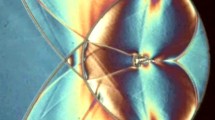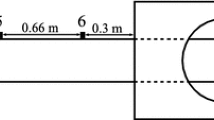Abstract
The problem of a plane shock wave that propagates in an air media and then is reflected from a parabolic concave reflector and focuses at some region is considered. The shock focusing can greatly magnify the pressure and the temperature. The purpose of this study is to numerically simulate the shock focusing process of the reflection of shock waves from the parabolic reflectors with different depths and to analyze their associated flow fields in detail. The present solver developed is to solve the Euler equations using an improved, implicit, upwind Total Variation Diminishing scheme in a finite-volume approach. The effects of reflectors with different depths and of the incident shock Mach numbers on shock focusing are investigated. The real-gas effect is taken into account through a proper correction of the specific heat ratio of air, when high temperature occurs due to shock focusing.
Similar content being viewed by others
References
Ben-Dor G (1992) Shock Wave Reflection Phenomena. Springer New York
Grönig H, Germany W (1985) Shock Wave Focusing Phenomena. Proceedings of the 15th International Symposium on Shock Waves and Shock Tubes, July 28–August 2, (ed. by Bershader) 1:43–56
Grossman B, Walters RW (1989) Analysis of Flux-Split Algorithm for Euler's Equations with Real Gases. AIAA Journal 27:524–531
Inoue O, Imuta S, Takayama K (1993) Shock Wave Focusing and Vortex Formation in Log-Spiral Ducts. Proceedings of the 5th International Symposium on Computational Fluid Dynamics I:313–316
Liang SM, Tsai CJ, Wu LN (1995) An Efficient, Robust Second-Order Total Variation Diminishing Scheme (to appear in AIAA Journal)
Perry RW, Kantrowitz A (1951) The Production and Stability of Converging Shock Waves. J Appl Phys 22:878–886
Sommerfeld M, Muller HM (1988) Experimental and Numerical Studies of Shock Wave Focusing in Water. Experiments in Fluids 6:209–216
Srinivasan S, Tannehill JC, Weilmuenster, KJ (1987) Simplified Curve Fits for the Thermodynamic Properties of Equilibrium Air. NASA RP-1181
Sturtevant B, Kulkarny VA (1976) The Focusing of Weak Shock Waves. J Fluid Mech 73:651–671
Takayama K, Ben-Dor G (1985) Reflection and Diffraction of Shock Waves over a Circular Concave Wall. Report No. 378, Institute of High Speed Mechanics, Tohoku University, Japan
Yee HC, Harten A (1987) Implicit TVD Schemes for Hyperbolic Conservation Laws in Curvilinear Coordinates. AIAA Journal 25:266–274
Yee HC, Klopfer GH, Montagne JL (1990) High-Resolution Shock-Capturing Schemes for Inviscid and Viscous Hypersonic Hows. Journal of Computational Physics 88:31–61
Whitham GB (1957) A new Approach to Problems of Shock Dynamics: Part I, Two-Dimensional Problems. J Fluid Mech 2:145–171
Author information
Authors and Affiliations
Rights and permissions
About this article
Cite this article
Liang, S.M., Wu, C.S., Yu, F.M. et al. Numerical simulation of shock wave focusing over parabolic reflectors. Shock Waves 5, 139–148 (1995). https://doi.org/10.1007/BF01435521
Received:
Accepted:
Issue Date:
DOI: https://doi.org/10.1007/BF01435521




